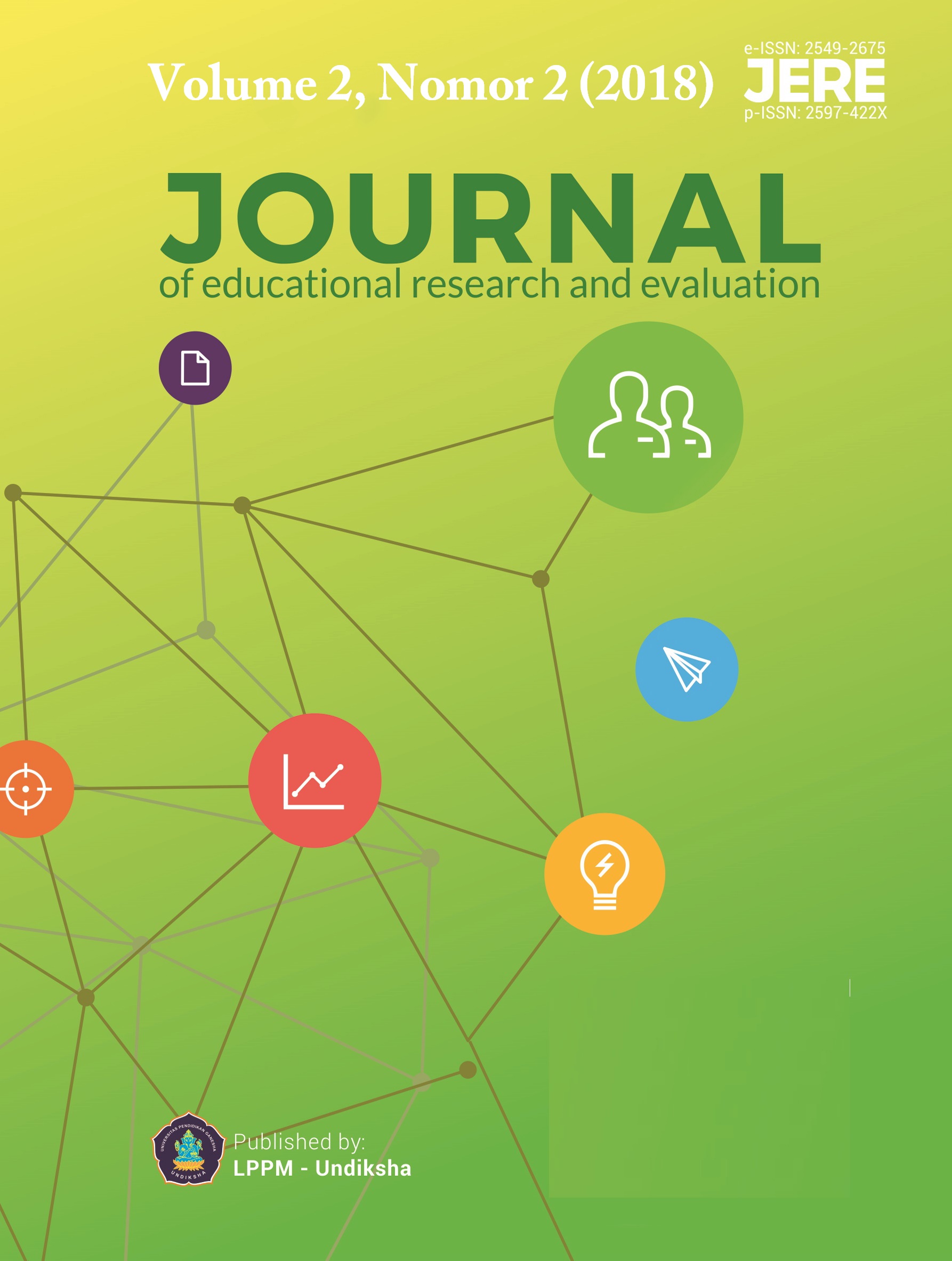Instructional Media Development for Teaching Japanese Language
DOI:
https://doi.org/10.23887/jere.v2i2.14453Keywords:
Multimedia Learning, Teaching Materials, Japanese Learning, TeachersAbstract
This research aims to develop multimedia teaching materials for teaching Japanese language at the senior high school. Using Adobe Flash CS5 software, this interactive media was technology based and provided some features found in the source book, such as vocabularies or sentence patterns introduction, etc. In addition this media also equipped by Japanese words pronounciation practice using Online Japanese Accent Dictionary (OJAD). This research was conducted with pre-experimental method, survey questionnaire and a short interview. Research subjects were teachers and students of senior high schools majoring Japanese language in Indonesia. Survey questionnaire result showed that this media was high rated as an attractive media and user-friendly media based on the contents and features provided on it. Further, it was found that this media was very useful not only for teachers as a teaching materials, but also for learners who are eager to learn Japanese independently.References
Branch, R. M. 2009. Instructional Design: The ADDIE Approach. Newyork : Springer Science Business Media.
Gulzar, Z. 2014. Educational System of J&K in the light of Evolutionary Multimedia Technology: A Case Study. International Journal of Advance Research in Computer Science and Management Studies. Volume 2, Issue 4, April 2014, pp. 66-75.
Karim, N.A and Shukur, Z. 2016. Proposed Features on An Online Examination Interface Design and Its Optimal Values. Computers in Human Behaviour, 64, 414-442.
Maryunita, R. 2017. Pemanfaatan Aplikasi Google Japanese Input dalam Meningkatkan Minat dan Kemampuan Membaca Teks Bahasa Jepang. Japanedu Journal. Vol. 2, No. 1, June 2017, pp. 20-28.
Mayer, R. E. 2005. Introduction to Multimedia Learning in R. E. Mayer (Ed). The Cambridge Handbook of Multimedia Learning. Newyork: Cambridge University Press.
Mayer, R. E. 2009. Multimedia Learning: Second Edition. Newyork: Cambridge University Press.
McGriff, S. J. 2000. Instructional System design: Using ADDIE Model. Available online at: https://www.lib.purdue.edu/sites/default/files/directory/butler38/ADDIE.pdf [July, 3rd 2017 Accesed]
Nawangnugraeni, D. A &Subiyanto. 2015. A New Variant of Android Educational Game as the Facility Introduction of Number for Early Childhood. Proceedings of the International Conference on Innovation in Engineering and Vocational Education, November 14, 2015. Bandung : Atlantis Press.
Neo, M & Neo, K. 2001. Innovative Teaching: Using Multimedia in a Problem Based Learning Environment. Educational Technology & Society 4(4) 2001.
Neo, M, Neo, K & Yap, W. 2008. Student`s Perceptions of Interactive Multimedia Mediated Web-Based Learning: A Malaysian Perspective. Proceedings Ascilite Melbourne 2008. http://www.ascilite.org.au/conferences/melbourne08/procs/neo.pdf
Haristiani, N & Firmansyah, D. B. 2017. Android Application For Enhancing Japanese JLPT N5 Kanji Ability. Journal of Engineering Science and Technology Special Issue on AASEC 2016, October (2017), pp. 106-114. School of Engineering, Taylor`s University.
SEG Research. 2008. Understanding Multimedia Learning: Integrating Multimedia in the K-12 Classroom. Available online at: https://www.brainpop.com/new_common_images/files/76/76426_BrainPOP_White_Paper-20090426.pdf [July, 3rd 2017 Accesed]
Setianingrum, M. 2017. Penggunaan Variasi Media Ajar Terhadap 3 Gaya Belajar Siswa Dalam Pembelajaran Bahasa Jepang. Japanedu Journal. Vol. 2, No. 1, June 2017, pp. 1-8.
Shank, P. 2008. The Value of Multimedia in Learning. The E-Learning Guild Online Forum 501, pp. 1-13.
Sugiyono. 2007. Metode Penelitian Bisnis. Bandung: Alfabeta.
Sorden, S. D. 2012. The Cognitive Theory of Multimedia Learning. Available online at: http://sorden.com/portfolio/sorden_draft_multimedia2012.pdf [July 27th 2017 Accessed]
Sumbawat, M.S & Munoto. 2015. The Development of Instructional Video to Illustrate Teaching in a Real Learning Environment. Proceedings of the International Conference on Innovation in Engineering and Vocational Education, November 14, 2015. Bandung : Atlantis Press.
Thyer, B. A. 2012. Quasi-Experimental Research Design. Oxford Scholarship Online: May 2012, DOI:10.1093/acprof:oso/9780195387384.003.0002.
Yanto, A.N & Djunaidi, A. 2011. Meningkatkan Keterampilan Membaca Bahasa Jepang Melalui Pemanfaatan Media Internet Situs JPLANG. TEKNOSASTIK Journal. Volume 9, Issue 2, 2011, pp. 47-52.
Downloads
Published
How to Cite
Issue
Section
License
Authors who publish with the Journal of Evaluation and Research in Education (JERE) agree to the following terms:
- Authors retain copyright and grant the journal the right of first publication with the work simultaneously licensed under a Creative Commons Attribution License (CC BY-SA 4.0) that allows others to share the work with an acknowledgment of the work's authorship and initial publication in this journal.
- Authors are able to enter into separate, additional contractual arrangements for the non-exclusive distribution of the journal's published version of the work (e.g., post it to an institutional repository or publish it in a book), with an acknowledgment of its initial publication in this journal.
- Authors are permitted and encouraged to post their work online (e.g., in institutional repositories or on their website) prior to and during the submission process, as it can lead to productive exchanges, as well as earlier and greater citation of published work. (See The Effect of Open Access)











